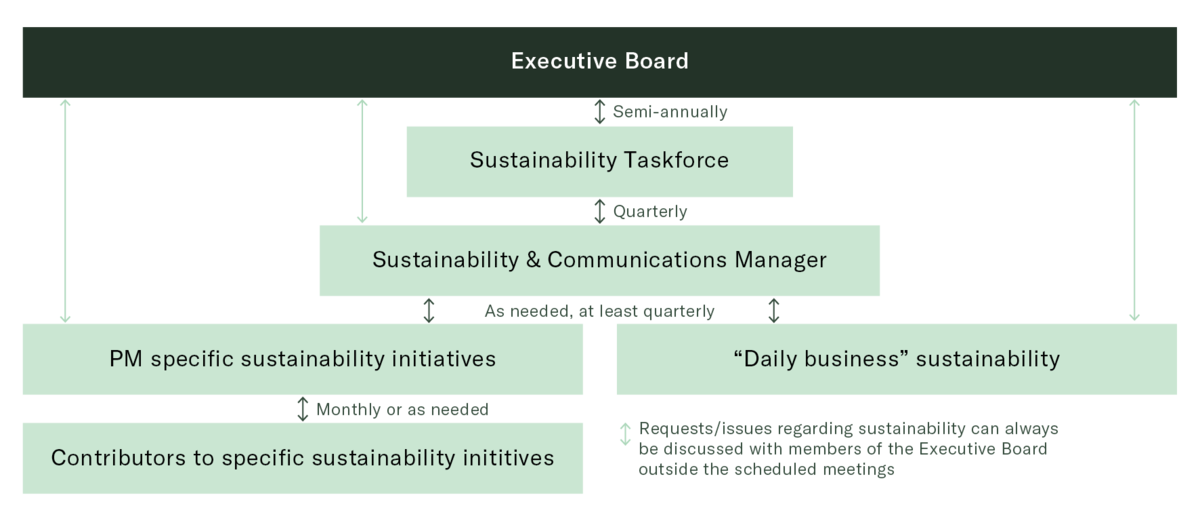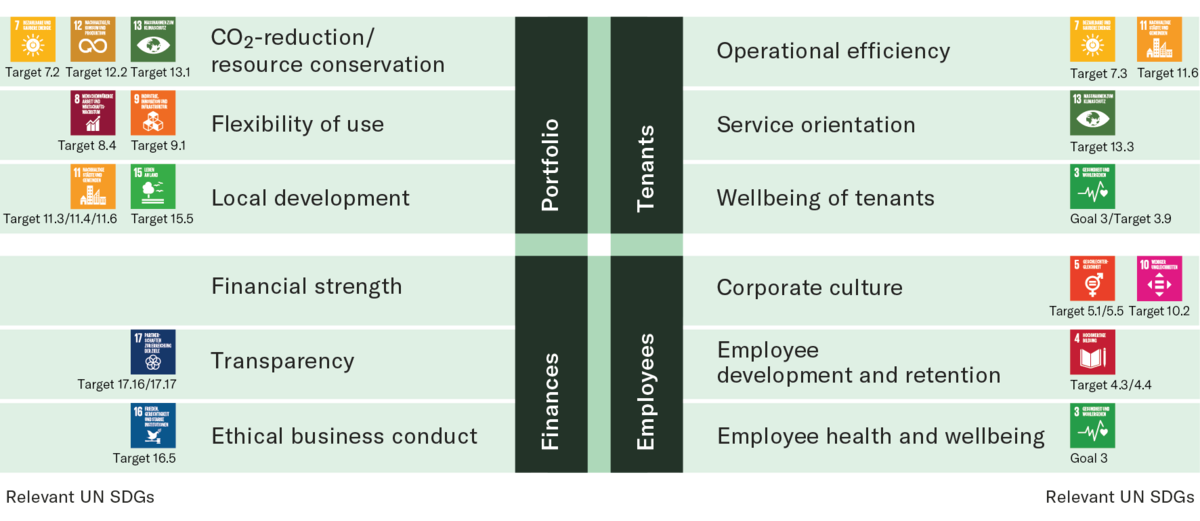
Sustainability organization
Our sustainability organisation is firmly anchored in the various departments. The priorities of our initiatives are based on our materiality analysis and the material issues derived from it. The projects that lead to the achievement of the strategic sustainability goals are defined annually.
Organisation
The steering and implementation of sustainability initiatives is carried out by a nine-member committee with representatives from the areas of property management, construction, asset management, business development, transactions, human resources and communication as well as the Chief Investment Officer. Activities are coordinated by the Communications and Sustainability department.
The sustainability initiatives and prioritisation are discussed and defined with the Executive Board. Implementation is the responsibility of the departments that are particularly involved. Selected individuals take on this responsibility as part of their job description or as project managers for a specific sustainability initiative.

Our key topics
Commercial properties are only sustainable if they are let and generate good rental income. This requires that tenants are satisfied and that the property and location quality as well as price and service are right. PSP Swiss Property strives to meet these requirements.
In 2019, we carried out a materiality analysis for the first time and revised it in 2021. The materiality analysis is an important basis for identifying material ecological, social and economic issues that influence our business activities and our long-term success.
We proceeded as follows:
1. Recording the demands of all stakeholders
Our most important stakeholders:
- Employees
- Investors
- Tenants
- Public, politics and environment
- Business partner
We recorded the main requirements with regard to our business activities by means of internal analyses, discussions and evaluations of documents (e.g. employee surveys, tenant surveys, external analysis of PSP Swiss Property), with special attention to sustainability. We have also analysed the positive and negative effects of our work on the environment and society. Furthermore, we considered in which areas we can and must be able to make a meaningful contribution to achieving the UN Sustainable Development Goals (UN SDGs).
2. Identifiying overarching themes
We identified themes under which we could summarise the varying demands of the stakeholders and the effects of our work on the environment and society. For example, we grouped the tenants' desire for low ancillary costs, the business partners' need for efficient cooperation and our own demands for effective management and cost control under the heading "operational efficiency". In the end, we defined 12 issues with which we could associate the most important demands.
3. Assigning topics
We allocated these 12 topics to the 4 impact areas of our business activities. The topics listed first are considered important by several stakeholders or are central from an ecological point of view (such as CO2 reduction and resource conservation). However, we consider all issues to be material. These environmental, social and economic issues will have a significant impact on our business and long-term success. We therefore ensure that they are incorporated into our business strategy accordingly.

Goals at a glance
The topics identified in the materiality analysis determine the priorities of our sustainability initiatives in the different impact areas of our business:
- Reduction of CO2 emissions (Scope 1 and 2) by 50% by 2035 compared to 2019
- Net zero CO2 emissions by 2050 (operational emissions, scopes 1, 2 and 3)
- 100% of owner-generated electricity from renewable sources by 2025
- Strengthening the circular economy
- Enhancement of the property environment including improved biodiversity
- High tenant satisfaction
- Motivated and healthy employees
- Maintaining a diverse workforce
- Conservative financing policy
Further information on our sustainability goals and measures can be found at the corresponding impact areas Portfolio, Tenants, Employees and Finance and disclosure.